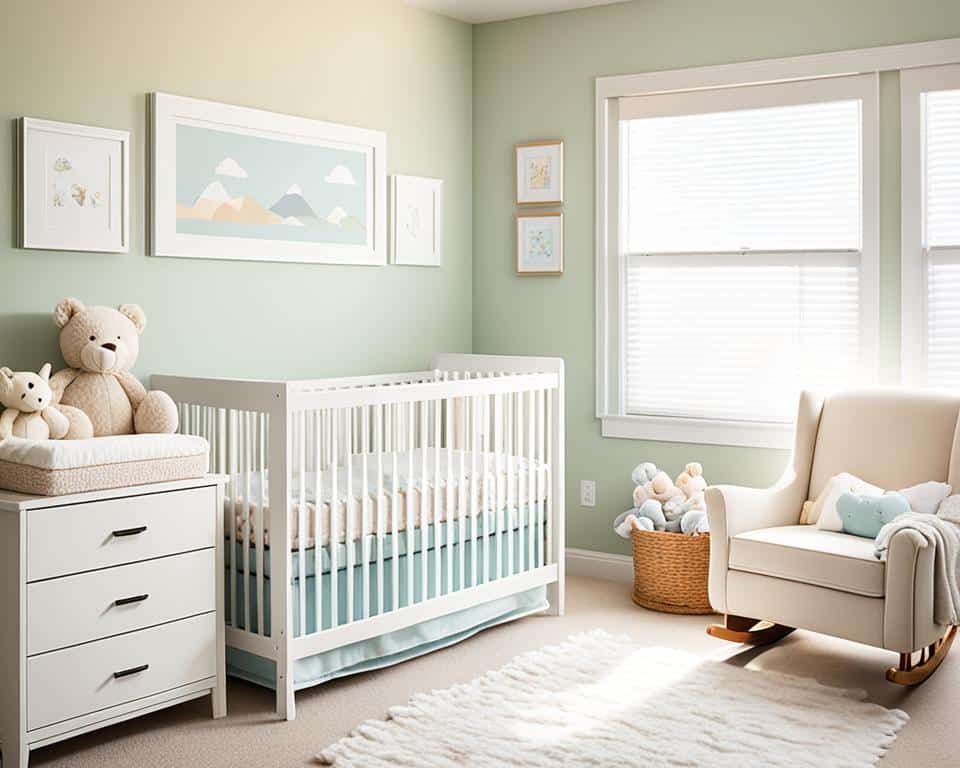When your baby gets a fever, night-time dressing is key. Keep them cool but comfy. Use light and breathable clothes, like a onesie or a sleep sack. These help your baby regulate their temperature and stay comfortable.
Avoid heavy layers and thick blankets. They can make the fever worse. Socks are fine for warmth. But, don’t overdo it with too many clothes.
It’s important to watch your baby’s temperature closely. If the fever is too high, a lukewarm bath can help. Water not too cold, not too warm, is best for them. Make sure your baby drinks plenty of fluids. This aids in the fever’s management.
Be careful with fever medicine. Always follow the correct dosage. Only give it if necessary. If the fever doesn’t go away or gets worse, see a doctor right away.
Key Takeaways
- Light clothing like a onesie or sleep sack is ideal for keeping a baby with fever comfortable at night.
- Monitoring the baby’s temperature throughout the night is crucial.
- Simple acts like lukewarm baths and good hydration can contribute significantly to fever management.
- Medications for fever should be given judiciously and in the correct dosages.
- Seeking medical advice is imperative if the fever is stubborn or presents with serious symptoms.
Understanding Fever in Infants
Fevers make parents worry, but they show the body’s fight against sickness. It’s important to know about fever signs and reasons to take better care of your baby’s health.
Identifying Fever Symptoms in Babies
Learning to catch infant fever symptoms early is important for taking care of your baby. Look for signs like a high body temperature, a warm flushed face, restlessness, and extra tiredness. Watch for if your baby seems more uncomfortable, is fussy, or eats less, as these signs are common with fever too.
Common Causes of Infant Fever
Baby fever causes can come from infections, teething, environmental things, and even vaccine reactions. Knowing what’s causing the fever helps with the right treatment. Always try to pinpoint the cause for the best care.
The Role of Body Temperature Regulation During Illness
When babies get sick, their bodies naturally turn up the heat to fight off bad germs. This fever response is a key part of the immune system. Yet, it’s important to keep fever at a safe level, as very high temperatures can cause harm.
If your baby’s fever is high or lasts long, it’s important to see a doctor. They can check for more serious illnesses and help keep your baby safe.
Overheating or elevated fever
| Symptom | Possible Cause | Recommended Action |
|---|---|---|
| Elevated body temperature | Infection | Monitor and consult a doctor if persists |
| Restlessness and fidgetiness | Teething or vaccination | Use teething rings, maintain calm |
| Reduced appetite | Infection or environmental factors | Ensure hydration, seek medical advice |
| Flushed face | Adjust room temperature, dress lightly |
Initial Steps for Managing Baby’s Fever at Home
Dealing with a fever at home is all about making your baby feel better and keeping them safe. Good baby fever care helps them cope with the symptoms using safe treatments. It’s important to know how to handle your baby’s fever well.
- Keep your baby well-hydrated with breast milk or formula. Use Pedialyte if they are vomiting to keep them from getting dehydrated.
- Give your baby simple, easy-to-digest foods because spicy or rich foods can make it worse.
- Don’t dress your baby too warmly. Too many layers can make the fever worse by holding in heat.
- Give them medicine made for babies, and make sure it’s the right dose for their weight.
Finding the right balance in dressing your baby for a fever is important. Here’s what to do with their clothes:
| Condition | Clothing Recommendation |
|---|---|
| Mild Fever | Light cotton onesie |
| Moderate to High Fever | Diaper alone or very light clothing |
| During Sleep | One light layer, like a soft sleep sack |
By using the right steps at home, you can help your baby feel better and stay safe. Keep an eye on how they’re doing and get help from a doctor if needed.
Choosing the Right Thermometer for Accurate Measurements
It’s crucial to get the right thermometer for an infant’s health. Especially in important health cases, it’s key to pick one that ensures accurate temperature measurements.
Rectal vs Oral Temperature Readings
The rectal thermometer is the best for precise readings in babies and young children. It matches their true body temperature closely. So, for accurate temperature measurements in kids, experts suggest this method.
Forehead Thermometers: Pros and Cons
Forehead thermometers are easy to use and gentle on kids. They avoid any discomfort or fuss. But, sometimes, they might not be as exact. Issues like the child sweating or an inaccurate position can affect their reading. That’s why they might not be the top choice for babies under 3. aqui>
| Type of Thermometer | Recommended Age Range | Accuracy |
|---|---|---|
| Rectal Thermometer | 0-3 years | High |
| Forehead Thermometer | 3+ years | Moderate |
When picking infant thermometers, knowing the differences is important. You want one that gives reliable readings for your child’s age. Accurate readings not only help with fever care but also with deciding if you need to see a doctor.
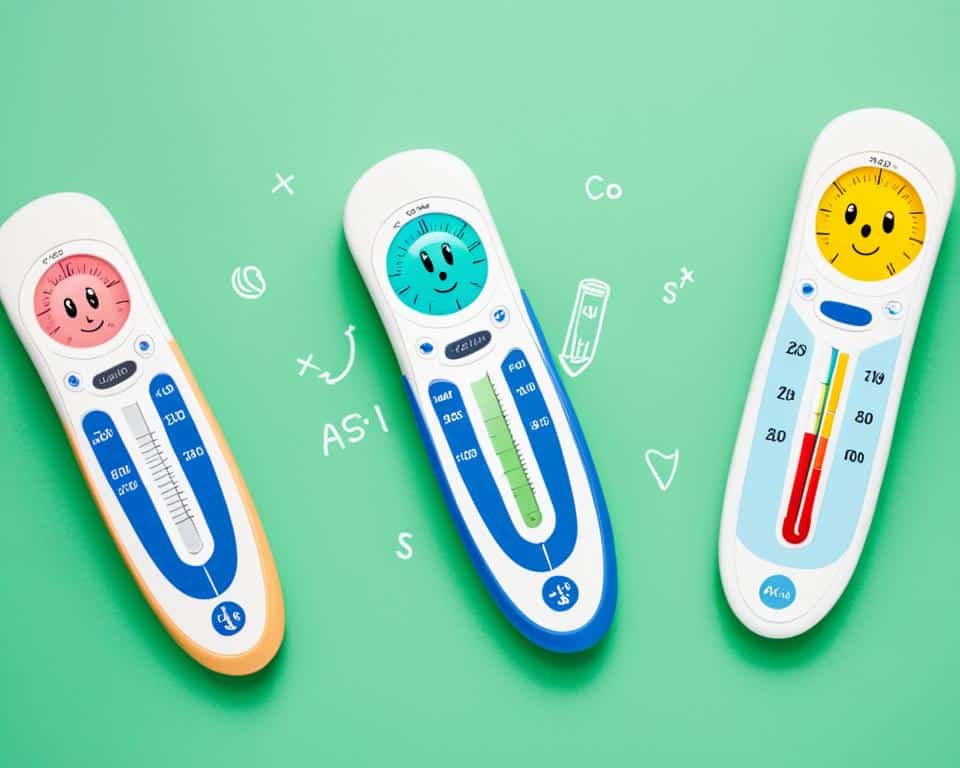
How to Dress Baby with Fever at Night
Dressing your baby right for the night during a fever is key for their comfort and safety. You need to find a balance. This means using breathable fabrics but not too many layers.
Selecting Appropriate Sleepwear for Fever Comfort
It’s important to pick the correct baby fever sleepwear. Go for lightweight, airy options like cotton. They help your baby’s skin breathe, stopping them from getting too hot. Simple sleep outfits like one-piece sleepers or soft cotton onesies work best. They keep your baby comfy without too much fabric that traps heat.
Balancing Baby’s Body Temperature with Layering
Layering is important, especially when night temperatures change. Just one layer of a natural fabric with a light blanket is enough. Avoid using many thick layers. They can make your baby too warm.
Choosing the right breathable baby fabrics is crucial when your baby has a fever. Fabrics like lightweight cotton or muslin are great choices. They keep your baby cozy while letting air circulate properly.
| Fabric Type | Benefits | Suitable for Fever? |
|---|---|---|
| Cotton | Soft, breathable, absorbs moisture | Yes |
| Muslin | Very lightweight, increases airflow | Yes |
| Polyester | Durable, less expensive | No |
The Significance of Hydration and Fever Management
Parenting brings many challenges, especially when dealing with a baby’s fever. It’s key to keep babies well-hydrated to maintain good health. This is even more important when they have a fever.
A baby loses fluids quickly when they have a fever. It’s crucial to make sure they drink enough. This helps control their body temperature and removes toxins. Regular breast milk or formula feedings are vital. If they start vomiting, giving them oral electrolytes helps prevent dehydration.
“Keeping your baby hydrated helps maintain critical bodily functions and can significantly aid in fever management.”
- Continual breast milk or formula intake
- Use of electrolyte solutions when necessary
- Monitoring for signs of dehydration such as fewer wet diapers
Be on the lookout for signs of dehydration in your baby. These may include less diapers, a dry mouth, or sunken eyes. If you see these signs, offer more fluids and seek a doctor’s advice.
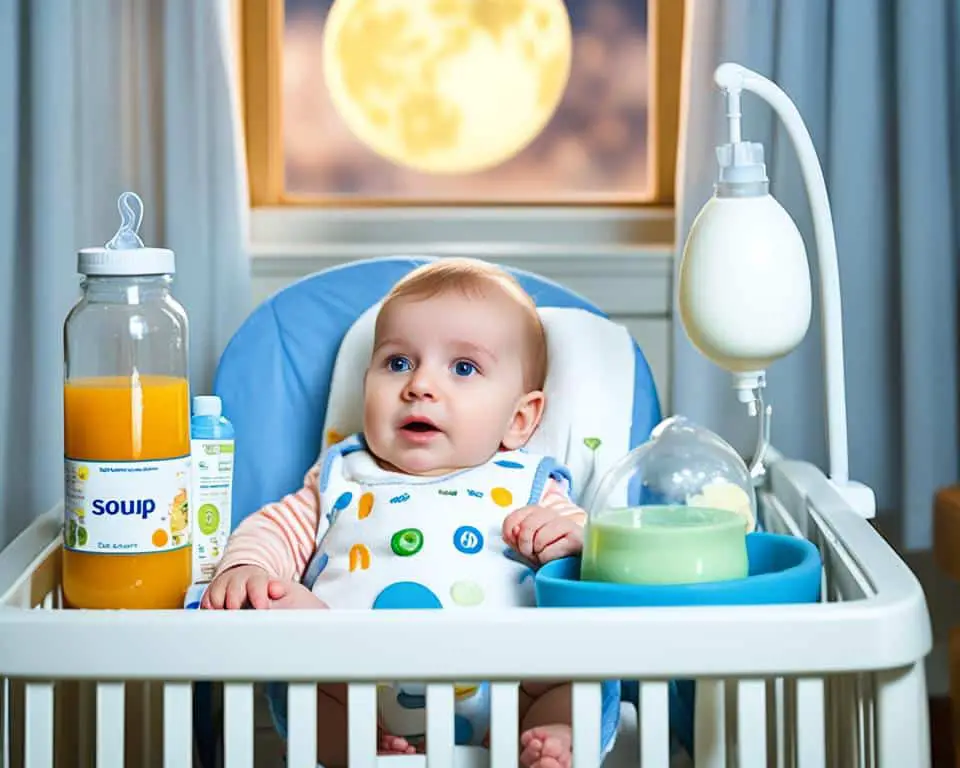
It’s crucial to balance hydration with fever care. Paying attention to baby fever hydration helps not only in managing the fever but also in maintaining the baby’s health.
Lightweight Clothing vs. Overdressing: What Science Says
When dressing infants, especially when they have a fever, it’s critical to know the right balance. Science suggests keeping it simple and comfortable can help with fevers.
Examining the Impact of Overdressing on Fever
Putting too many clothes on babies can make them even hotter. This makes fevers worse by keeping the extra heat close to their bodies.
Benefits of Lightweight Fabrics for Sick Infants
Picking lightweight baby clothing helps babies stay at a good temperature and feel cozy. It not only cools them down but also helps them stay calm and sleep well. Let’s look at how different infants’ sleepwear types affect them:
| Sleepwear Type | Material | Advantages | Disadvantages |
|---|---|---|---|
| Standard Baby Romper | Cotton | Soft, breathable, comfortable | May not be sufficient in colder climates without additional heating |
| Heavy Baby Blanket | Synthetic Fibers | Warm | Can overheat, risk of increasing fever |
| Lightweight Baby Blanket | Cotton/Muslin | Light, airy, maintains comfortable body temperature | May require extra layering in cooler conditions |
Choosing the right infants’ sleepwear is key to dealing with a fever. It’s vital to pick clothes that don’t make the baby too hot.
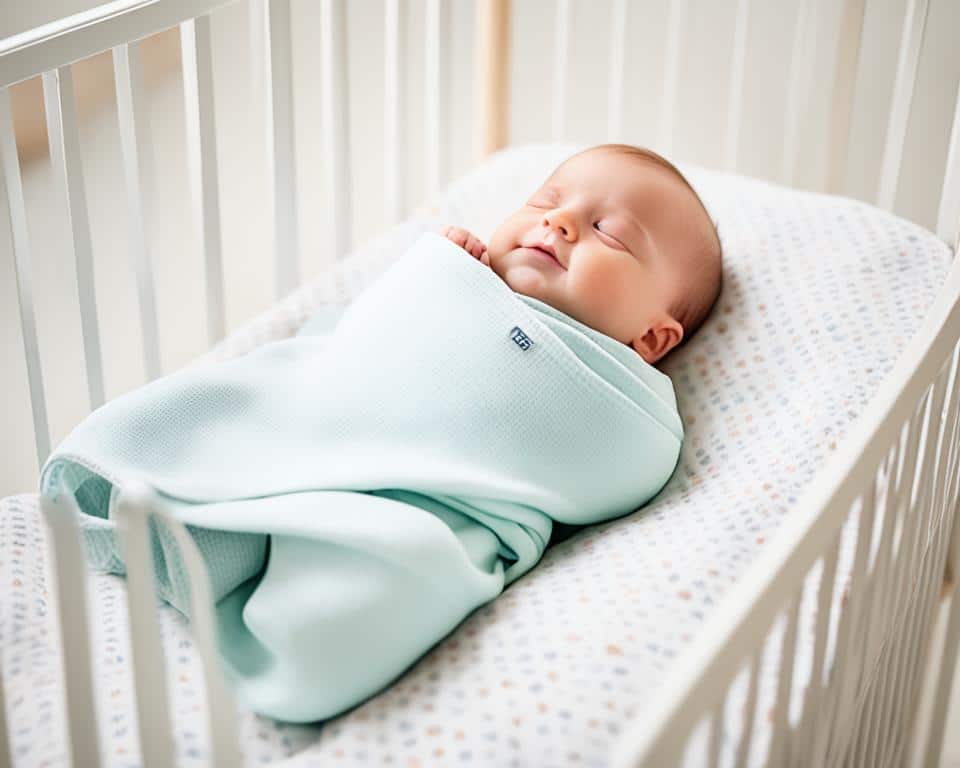
Creating a Comforting Environment for a Feverish Baby
When your baby has a fever, setting up a comforting environment for feverish baby matters a lot. It helps them feel better and get well faster. A well-kept pediatric sleep environment is key to keeping your baby calm. It makes sure they rest well even when they’re sick.
First, make sure the room is neither too cold nor too hot. A comfortable temperature is important. This stops your baby from getting more uncomfortable. Using a fan can help circulate air, but it shouldn’t be right on the baby. Start with these baby fever care tips to help your baby feel more at ease and calm.
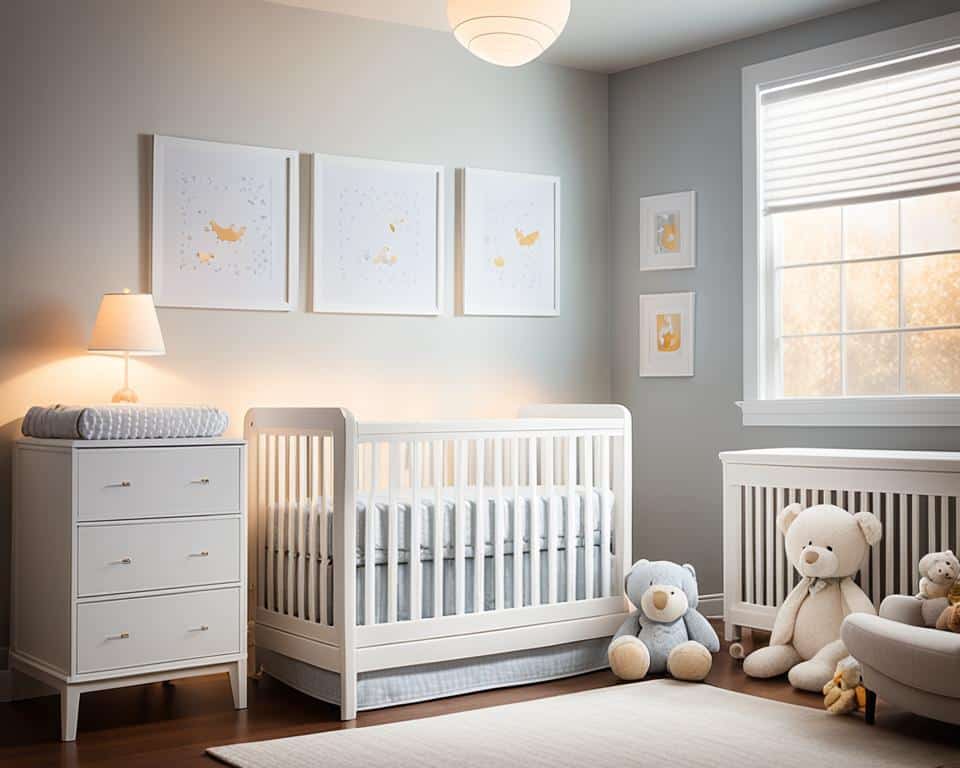
- Maintain a room temperature around 68-72°F (20-22°C), which is generally comfortable and safe for a sick baby.
- Use a digital thermometer to regularly monitor the room temperature, adjusting it when necessary.
- Consider soft, ambient lighting to help create a restful sleeping environment.
- Ensure bedding is lightweight and breathable, avoiding heavy blankets or excessive layers.
If you keep up with these steps, your baby’s recovery space will be ideal. A peaceful and comforting environment for feverish baby means more than just the right temperature. It’s also creating a calm, soothing place for them to get better sleep.
When to Administer Fever-Reducing Medication
When it comes to giving an infant fever-reducing medicine, several key things must be looked at. This includes the child’s symptoms, age, and how much they weigh. Doing this check ensures the medicine works well and is safe for your child.
Understanding Acetaminophen and Ibuprofen Dosage
To figure out how much baby acetaminophen or pediatric ibuprofen to give, always use guidelines from doctors or trusted charts. These drugs can help lower a child’s fever and make them feel better. But be careful to not give too much to avoid side effects.
Recognizing the Signs When Medication is Necessary
Knowing when to use fever-reducing medication is key. You should consider giving medicine if the fever is really making your baby uncomfortable. Or if the fever comes with other bad signs, like not eating or reacting slowly.
Here’s a clear look at acetaminophen and ibuprofen dosages by age and weight:
| Medication | Age Group | Dosage | Notes |
|---|---|---|---|
| Acetaminophen | 0-3 Months | Consult Physician | Only under doctor’s advice |
| Acetaminophen | 4-11 Months | 40-120 mg every 4-6 hours | Not to exceed 5 doses in 24 hours |
| Ibuprofen | 6+ Months | 50 mg every 6-8 hours | Not to exceed 4 doses in 24 hours |
Fever-reducing meds are very helpful when a baby is sick. But, always check with a doctor before you give them. This is extra important for babies less than three months old or if your baby has had health problems before.
Monitoring and Adjusting Baby’s Nighttime Comfort Levels
It’s vital to keep your baby comfortable while they sleep, especially when they have a fever. For this, keep an eye on their monitoring baby fever. Also, it’s crucial to pick the right clothing. This choice makes a big difference in your baby’s infant comfort levels. And, you need to adjust their sleepwear when the weather changes during the night.
The temperature of their room is very important for your baby’s care at night. For the best sleep, the room should be between 68℉ and 72℉ (20℃ – 22℃). If it’s colder or hotter, you might need to change what they wear to keep them comfy and avoid fever issues.
| Room Temperature | Sleepwear Adjustment |
|---|---|
| Bellow 68℉ (20℃) | Add a breathable layer |
| Above 72℉ (22℃) | Lighten sleepwear |
It’s best to check the room temperature yourself. Sometimes, baby monitors don’t give the right temperature. Always verify with a thermometer to be sure your baby isn’t too hot or cold.
The experts say that babies should wear one more layer of clothes than adults do. This keeps them just right through the night when they’re feeling sick. Remember, don’t make them too hot by adding too many clothes or a hat.
The main aim is to keep your baby just the right temperature. You may need to change what they wear or the room to make sure they are cozy all night. Checking and adjusting things often is key to a good night’s sleep when they’re fighting a fever. This is very important for their recovery during nighttime fever care.
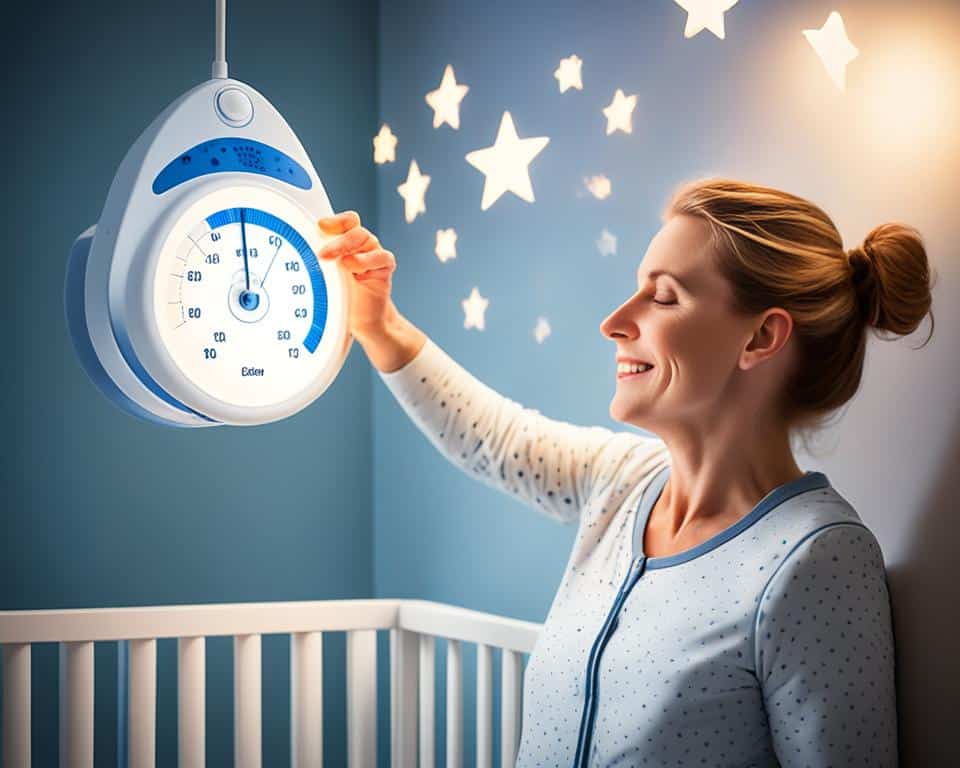
When to Seek Professional Medical Advice
Knowing when to get medical advice is essential for your baby’s health. It’s important to spot the early signs. This can help prevent problems and make sure your baby gets help quickly. Know when you need to see a doctor fast, and when talking to a pediatrician is a must.
Recognizing Emergency Symptoms Alongside Fever
It’s key to understand when a baby’s fever could mean something more serious. If your baby has a fever and shows these signs, you need to act right away:
- Difficulty breathing
- Rash or purple spots that look like bruises on the skin
- Seizures
- Inconsolable crying or discomfort
- Unresponsive or lethargic behavior
If you notice these signs, see a healthcare provider as soon as possible. They will help figure out the cause and what to do next.
Understanding When to Consult a Pediatrician
Sometimes, you should get advice from a pediatrician even if the signs are not life-threatening. They should check your baby if:
- Fever in a baby younger than 3 months
- Fever that lasts more than 48 hours in babies of any age
- Signs of dehydration like dry diapers, lack of tears when crying, or dry mouth
It’s better to be safe and talk to a pediatrician. They can make sure your baby is healthy.
| Age Group | Actions | When to Seek Further Medical Attention |
|---|---|---|
| Under 3 months | Monitor fever regularly, ensure hydration | If fever exceeds 100.4°F or persists |
| 3-6 months | Hydrate, check for additional symptoms | If fever reaches 101°F or complete loss of appetite |
| Older than 6 months | Continue hydration, offer comfort | If fever lasts more than 48 hours or with severe symptoms |
Conclusion
In managing pediatric fever, parents have a big part especially at night when fevers often rise. Choosing the right clothes for your baby is key. Use light clothes that are easy to breathe in to help keep your baby comfortable. It’s also important to keep the room not too hot, around 20-22°C/68-72°F, for your baby’s health.
Many fevers in babies come from infections, so keeping an eye on the baby’s temperature is vital. If their temperature is over 100.4°F (38°C) rectally or 99°F (37.2°C) orally, it’s a sign to act. Making sure they drink enough is a great way to help manage their fever.
For baby fever night care, remember, simple and watchful care is best. Use fewer clothes, keep their sleeping area peaceful, and ask the right questions about medicine. But, if the fever doesn’t go away or your baby shows other worrying signs, it’s time to see a doctor. Good care, being alert, and getting help if needed are the keys to making your baby better.

